Catalpa bignonioides extract improves exercise performance through regulation of growth and metabolism in skeletal muscles
Hoibin Jeong ,Dong-joo Lee ,Sung-Pil Kwon ,SeonJu Park ,Song-Rae Kim ,Seung Hyun Kim ,Jae-Il Park,Deug-chan Lee,Kyung-Min Choi,WonWoo Lee,Ji-Won Park,Bohyun Yun,Su-Hyeon Cho✉,Kil-Nam Kim,8✉
1Seoul Center, Korea Basic Science Institute, Seoul 02841, Republic of Korea
2Chuncheon Center, Korea Basic Science Institute, Chuncheon 24341, Republic of Korea
3Research &Development Center, Chungdam CDC JNPharm LLC., Chuncheon 24341, Republic of Korea
4Department of Biomedical Technology, Kangwon National University, Chuncheon 24341, Republic of Korea
5Yonsei Institute of Pharmaceutical Sciences, College of Pharmacy, Yonsei University, Incheon 21983, Republic of Korea
6Gwangju Center, Korea Basic Science Institute, Gwangju 61751, Republic of Korea
7Honam National Institute of Biological Resources, 99, Gohadoan-gil, Mokpo-si, Jeollanam-do, 58762, Republic of Korea
8Department of Bio-analysis Science, University of Science &Technology, Daejeon, 34113, Republic of Korea
ABSTRACT Objective:To evaluate the effects of Catalpa bignonioides fruit extract on the promotion of muscle growth and muscular capacity in vitro and in vivo.Methods:Cell viability was measured using the 3-(4,5-dimethylthiazol-2-yl)-2,5-diphenyltetrazolium bromide assay.Cell proliferation was assessed using a 5-bromo-2’-deoxyuridine (BrdU) assay kit.Western blot analysis was performed to determine the protein expressions of related factors.The effects of Catalpa bignonioides extract were investigated in mice using the treadmill exhaustion test and whole-limb grip strength assay.Chemical composition analysis was performed using high-performance liquid chromatography (HPLC).Results:Catalpa bignonioides extract increased the proliferation of C2C12 mouse myoblasts by activating the Akt/mTOR signaling pathway.It also induced metabolic changes,increasing the number of mitochondria and glucose metabolism by phosphorylating adenosine monophosphate-activated protein kinase.In an in vivo study,the extract-treated mice showed improved motor abilities,such as muscular endurance and grip strength.Additionally,HPLC analysis showed that vanillic acid may be the main component of the Catalpa bignonioides extract that enhanced muscle strength.Conclusions:Catalpa bignonioides improves exercise performance through regulation of growth and metabolism in skeletal muscles,suggesting its potential as an effective natural agent for improving muscular strength.
KEYWORDS: Catalpa bignonioides;Skeletal muscle;Cell proliferation;Mitochondria;Energy metabolism;C2C12
1.Introduction
The annual loss of skeletal muscles occurs at a rate of approximately 2% from the age of 40 to 80 years[1,2].This condition may develop into sarcopenia (a muscle loss disease);therefore,preventing skeletal muscle loss and maintaining muscle mass in the elderly is crucial for an energetic life in old age[3].The mechanism regulating skeletal muscle mass remains unclear.However,the insulin-like growth factor 1 (IGF-1)/Akt/mammalian target of rapamycin (mTOR) signaling pathway and myogenesis pathway are significantly linked to skeletal muscle maintenance[4-8].The decrease in skeletal muscle mass is caused by various factors such as oxidative stress,mitochondrial dysfunction,apoptosis,excessive autophagy,and lack of hormone homeostasis in muscle cells[9,10].Moreover,metabolic functions in muscle cells are dysregulated when the rate of myofibrillar protein degradation exceeds the rate of protein synthesis,thereby reducing skeletal muscle mass[11].Therefore,it is necessary to stimulate muscle cell metabolism and maintain skeletal muscle mass for optimal performance.
Anabolic steroids and drugs are widely applied for muscle growth and maintenance;however,their prolonged or excessive use is associated with various side effects such as alopecia,Cushing’s syndrome,osteoporosis,diabetes,myocardial infarction,and cancer[12-14].Therefore,natural products and plant compounds are proposed as alternative medicines to compensate for the side effects of anabolic steroids.For instance,black ginseng improves myoblast differentiation and myotube growth by enhancing the Akt/mTOR/P70S6K signaling pathway[15].Furthermore,Cichorium intybusroot extract suppresses oxidative stress-induced apoptosis,and many other natural resources exert positive effects on muscle cells[16].However,many reports are limited to studies at the cellular level,and further research on theirin vivoapplicability is still lacking.
Catalpa bignonioides(C.bignonioides) Walt.(Bignoniaceae) is a species widely used for medicinal purposes for treating gastric diseases,helminthic infections,oncological diseases,bronchial diseases,carbuncles,scabs,and abscesses in indigenous cultures of South America[17].Phytochemical studies show thatC.bignonioidesextract contains phenols,terpenes,alkaloids,tannins,fats,and sugars[18].In North American traditional medicine,C.bignonioidesextract was used to treat bronchial diseases and has demonstrated antioxidant,anti-inflammatory,and antinociceptive effects[18].In addition,C.bignonioidespods,seeds,leaves,and roots can treat many diseases such as ulcers,skin,respiratory diseases,scrofulous maladies,and helmintic infections[19,20].In addition,otherCatalpaspecies show anti-diabetic effects in mouse models,and their efficacy has been confirmed when the substance is incorporated into their diet[21].Catalpic acid is abundant in the Bignoniaceae family includingC.bignonioidesand improves glucose homeostasis when fed to mice[22].Our previous study demonstrated that vanillic acid and pinoresinol fromC.bignonioidessignificantly increase the proliferation of C2C12 mouse myoblasts by regulating the IGF-1/Akt/mTOR signaling pathway[23].However,it only included specific components of theC.bignonioidesextract and did not explore theinvivoefficacy of the extract.
Therefore,this study aimed to evaluate whether oral administration of theC.bignonioidesextract improves exercise performance in a mouse experimental model.
2.Materials and methods
2.1.Materials
Dulbecco’s modified Eagle’s medium (DMEM) was purchased from Welgene (Gyeongsangbuk-do,Korea).Fetal bovine serum(FBS) was provided by Omega Scientific,Inc.(Tarzana,CA,USA).Penicillin and streptomycin were purchased from Invitrogen(Carlsbad,Cam USA).Horse serum (HS),3-(4,5-dimethylthiazol-2-yl)-2,5-diphenyltetrazolium bromide (MTT),dimethyl sulfoxide(DMSO),and radioimmunoprecipitation assay buffer were purchased from Sigma-Aldrich (St.Louis,MO,USA).The 5-bromo-2’-deoxyuridine (BrdU) assay kit was purchased from Millipore (Billerica,MA,USA).The NuPAGE 4%-12% Bis-Tris gel was purchased from Life Technologies (Carlsbad,CA,USA).Polyvinylidine fluoride membranes were purchased from Bio-Rad Laboratories (Hercules,CA,USA).Rabbit anti-mouse phospho-Akt(Cat no.4060;1∶1 000),rabbit anti-mouse phospho-mTOR (Ser2448,Cat no.5536;1∶1 000),rabbit anti-mouse phospho-ribosomal protein S6 kinase (p70S6K,Cat no.9204;1∶1 000),rabbit anti-mouse phospho-eukaryotic initiation factor 4E-binding protein 1 (4E-BP1,Cat no.2855;1∶1 000),mouse anti-mouse glucose transporter type 4 (GLUT4,Cat no.2213;1∶1 000),rabbit anti-mouse phospho-AMPKα (Cat no.2535;1∶1 000),rabbit anti-human phospho-sirtuin 1 (Sirt1,Cat no.2314;1∶1 000),rabbit anti-human peroxisome proliferator-activated receptor gamma coactivator 1-alpha (PGC-1α;Cat no.2178;1∶1 000),peroxisome proliferator-activated receptor gamma (PPARγ;Cat no.2443;1∶1 000),goat anti-rabbit IgG (Cat no.7074,1∶3 000),and goat anti-mouse IgG (Cat no.7076;1∶3 000)were purchased from Cell Signaling Technology (Danvers,MA,USA).Mouse anti-human myoblast determination protein 1 (MyoD,Cat no.sc- 377460;1∶1 000),mouse anti-human myogenin (Cat no.sc-12732;1∶1 000),and mouse anti-human β-actin (Cat no.sc-47778;1∶1 000) were purchased from Santa Cruz Biotechnology(Dallas,TX,USA).The SuperSignal West Femto Trial Kit and radioimmunoprecipitation assay (RIPA) were purchased from Thermo Fisher Scientific (Waltham,MA,USA).Serum alanine aminotransferase (ALT) and aspartate aminotransferase (AST)levels were measured using colorimetric assay kits purchased from BioVision (Milpitas,CA,USA).
2.2.Preparation of C.bignonioides extract
The fruits ofC.bignonioidescollected from the Medicinal Herb Garden,College of Pharmacy,Seoul National University in Goyang,Gyeonggi-do,Korea,in 2021 were certified by Sang Il Han,the general manager of the Medicinal Herb Garden.A voucher sample(CB202106) was deposited with the Korea Basic Science Institute(Chuncheon,Korea).The samples were washed with fresh water to remove sand and dust,and dried at room temperature for 1 week.Dried samples (500 g) were extracted using 70% ethanol (5 L) with continuous agitation at 37 ℃.The solvent was removed using a vacuum rotary evaporator,and the extract was stored at -20 ℃ until use.
2.3.Cell culture and differentiation
C2C12 cells,belonging to a murine myoblast cell line,were maintained in DMEM containing 10% FBS,penicillin (100 U/mL),and streptomycin (100 μg/mL).For differentiation,the medium was replaced with DMEM supplemented with 2% HS when the cell confluence reached approximately 80%,which was subsequently replaced every alternate day,and differentiation was performed for 6 d.All cell cultures were maintained at 37 ℃ in a 5% CO2incubator.
2.4.Cytotoxicity assay
C2C12 cells (1 × 105cells/mL) were seeded in 96-well plates and incubated withC.bignonioidesextracts (6.25-50 μg/mL) for 24 h.Next,100 μg/mL MTT was added to each well and incubated for 2.5 h at 37 ℃.The supernatant was removed,and cells were treated with DMSO to dissolve formazan crystals.The absorbance of the colored solution was determined at 540 nm using a SpectraMax M2/M2e spectrophotometer (Molecular Devices,San Jose,CA,USA).
2.5.Cell proliferation activity
Skeletal muscle cell proliferation activity was assessed using a colorimetric assay.C2C12 cells (5 × 104cells/mL) were seeded in a 96-well plate,and the medium was replaced with DMEM supplemented with 2% HS 2 days later for differentiation.TheC.bignonioidesextract (6.25-50 μg/mL) was added whenever the medium (2% HS-containing DMEM) was changed every alternate day.To evaluate the effect ofC.bignonioidesextract on the proliferation of skeletal muscle cells,a BrdU cell proliferation assay was conducted during the differentiation period,as reported previously[23-26].Cell proliferation was measured using the BrdU assay kit 6 days after inducing differentiation,according to the manufacturer’s instructions.
2.6.Western blot analysis
Cell lysates were prepared using RIPA buffer[23].Quantified protein lysates were loaded onto NuPAGE 4%-12% Bis-Tris gels,which were subsequently blotted onto a polyvinylidene fluoride membrane.Primary antibodies (each diluted 1∶1 000,including rabbit anti-mouse phospho-Akt,rabbit anti-mouse phospho-mTOR,rabbit anti-mouse phospho-p70S6K,rabbit anti-mouse phospho-4E-BP1,mouse anti-mouse MyoD,mouse anti-mouse myogenin,mouse anti-mouse GLUT4,rabbit anti-mouse phospho-AMPKα,rabbit anti-mouse phospho-Sirt1,rabbit anti-human PGC-1α,rabbit anti-mouse PPARγ,and mouse anti-mouse β-actin) were added to cover the membrane and incubated overnight at 4 ℃.Subsequently,secondary antibodies (diluted 1∶3 000,including goat anti-rabbit IgG and goat anti-mouse IgG) were added,followed by incubation for 1.5 h at 25 ℃.Signals were developed using the SuperSignal West Femto Trial Kit,and images were acquired using Fusion FX (Vilber Lourmat Ste,Collegien,France).
2.7.Treadmill exhaustion test and whole-limb grip strength assay
Six-week-old ICR male mice (Nara-Biotec,Korea) were maintained under controlled conditions of temperature [(23 ± 2) ℃],humidity [(55 ± 5)%],and light (12-h light/dark cycle) at the Korea Basic Science Institute (KBSI);and they had access to food and waterad libitum.
To evaluate thein vivoefficacy of theC.bignonioidesextract,mice were randomized into four groups with at least 8 mice in each group,and orally administered distilled water,200 mg/kg of creatine,50 mg/kg ofC.bignonioidesextract,or 200 mg/kg ofC.bignonioidesextract daily for 10 weeks.To confirm the biotoxicity or liver damage ofC.bignonioidesextract in mice,ALT and AST levels were determined using colorimetric assay kits.Mice were acclimatized to treadmill running through training for 5 min at a speed of 10 m/min on the Exer 3/6 treadmill (Columbus Instruments;Columbus,OH,USA) with a 10% uphill slope for 3 d before the test.The mice were subjected to an endurance test until exhaustion.The treadmill was initially run at a speed of 10 m/min for 5 min,and the speed was increased by 2 m/min every 2 min.The running time,distance,and maximum speed until exhaustion were recorded for each mouse.Exhaustion was defined as when a mouse could not run on the treadmill for over 10 s despite mechanical prodding[27].In the wholelimb grip strength assay,the tail of each mouse was horizontally pulled when they grabbed a grid,and the maximum force was recorded using a grip strength meter (Ametek;Paoli,PA,USA)[20].Each mouse was tested at least twice for 3 d.The thigh thickness of mice was measured using a caliper.
2.8.High-performance liquid chromatography (HPLC)analysis
Chemical (vanillic acid and pinoresinol) composition was analyzed using UFLC LC-20A (Shimadzu,Kyoto,Japan) with a UV detector at 254 nm using the PRONTOSIL 120-5-C18 ACE-EPS column (5 μm,250 mm × 4.6 mm).A flow rate of 1.0 mL/min was maintained for elution using a mobile phase solvent system containing 0.1% (v/v) formic acid in water (A) and acetonitrile (B) (30% B;3 min,50%B;3-20 min,90% B;20-25 min,90% B;25-27 min,30% B;27-28 min,30% B;28-35 min).
2.9.Statistical analysis
Statistical analyses of data were performed using a two-tailed oneway analysis of variance with Tukey’spost-hoctest using Prism(Version 4.00;GraphPad Inc.;La Jolla,CA,USA).Data were considered statistically significant atP< 0.05.
2.10.Ethical statement
All animal experiments were approved by the Institutional Animal Care and Use Committee at KBSI (KBSI-IACUC-21-30).
3.Results
3.1.C.bignonioides extract enhances skeletal muscle cell proliferation
Before examining the effect ofC.bignonioidesfruit extract on the proliferation of muscle cells,its cytotoxicity to C2C12 mouse myoblasts was evaluated using the MTT assay.No cytotoxic effect was observed up to 50 μg/mL (P>0.05) (Figure 1A).
No effect on cell proliferation was detected in skeletal muscle cells treated with 6.25 μg/mLC.bignonioidesfruit extract;however,12.5 and 25 μg/mL extracts significantly increased cell proliferation (P<0.01).Elevated cell proliferation was also observed at 50 μg/mL (P<0.05),although the level was reduced compared with that observed at 25 μg/mL(Figure 1B).
3.2.C.bignonioides extract stimulates the Akt/mTOR signaling in skeletal muscle cells
Western blot analyses were conducted to elucidate the molecular mechanism by whichC.bignonioidesextract enhances cell proliferation.We observed significantly elevated levels of phosphorylated Akt,mTOR,and p70S6K and downregulation of phosphorylated 4E-BP1 (a translational repressor) in C2C12 cells treated withC.bignonioidesextract (P<0.001) (Figure 2).In addition,Myo D was activated during muscle differentiation and considerably increased following treatment with the extracts (P<0.01).C.bignonioidesextract at 12.5 μg/mL significantly upregulated the expression of myogenin (P<0.01),but no significant change was observed after treatment with 25 μg/mL of the extract (P>0.05).
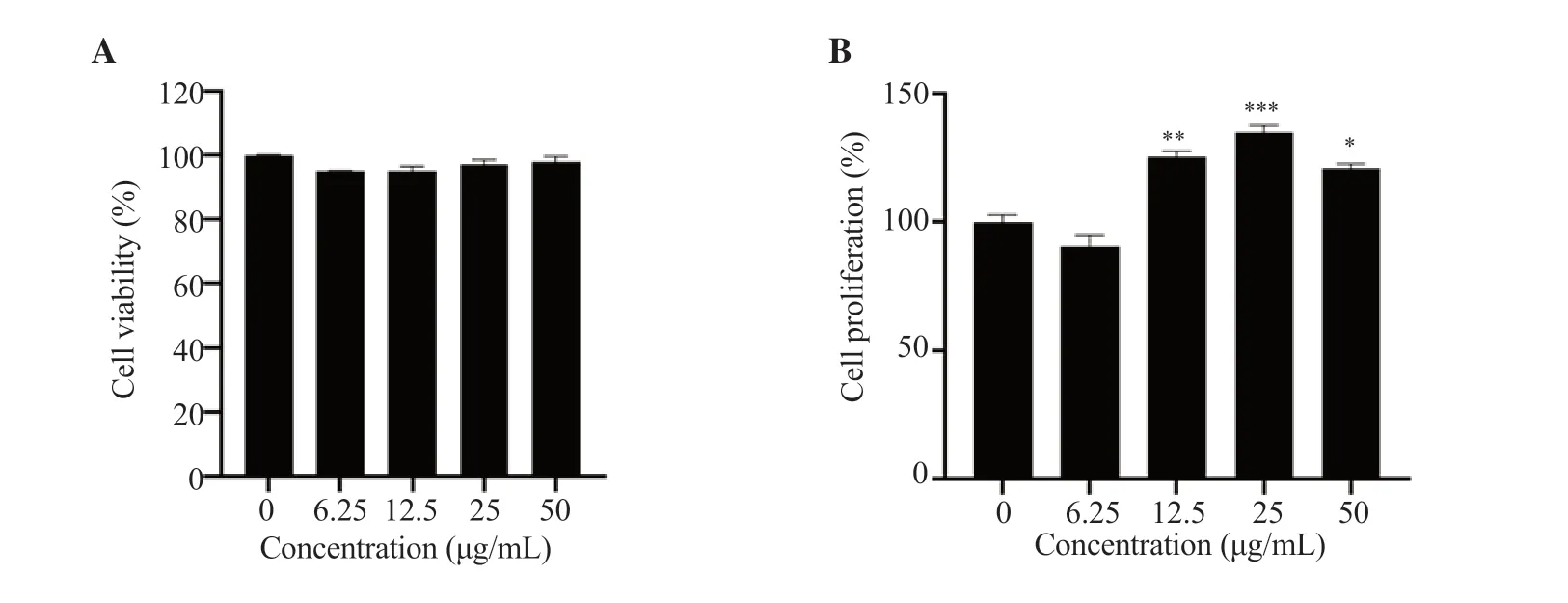
Figure 1.Effect of Catalpa bignonioides fruit extract on mouse myoblast proliferation.(A) Cytotoxic effects of various concentrations of Catalpa bignonioides extract on C2C12 cells by MTT assay.(B) Effects of various concentrations of Catalpa bignonioides extract on the differentiation of C2C12 cells.Data are represented as mean ± SEM of measurements in at least triplicate.*,**,and *** indicate P < 0.05,P < 0.01,and P < 0.001 compared with the control,respectively.
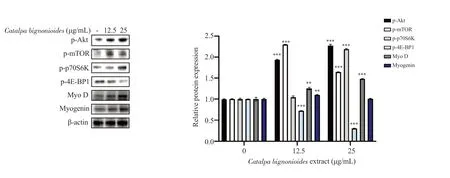
Figure 2.Effect of Catalpa bignonioides extract on the expression of p-Akt,p-mTOR,p-p70S6K,and p-4E-BP1,Myo D,and myogenin in C2C12 mouse myoblasts.The levels of IGF-1 signaling (p-Akt,p-mTOR,p-p70S6K,and p-4E-BP1),Myo D,and myogenin were determined using Western blot analysis.β-actin was used as the loading control.Data are represented as mean ± SEM of measurements in at least triplicate.**,and *** indicate P < 0.01,and P < 0.001 compared with the control,respectively.
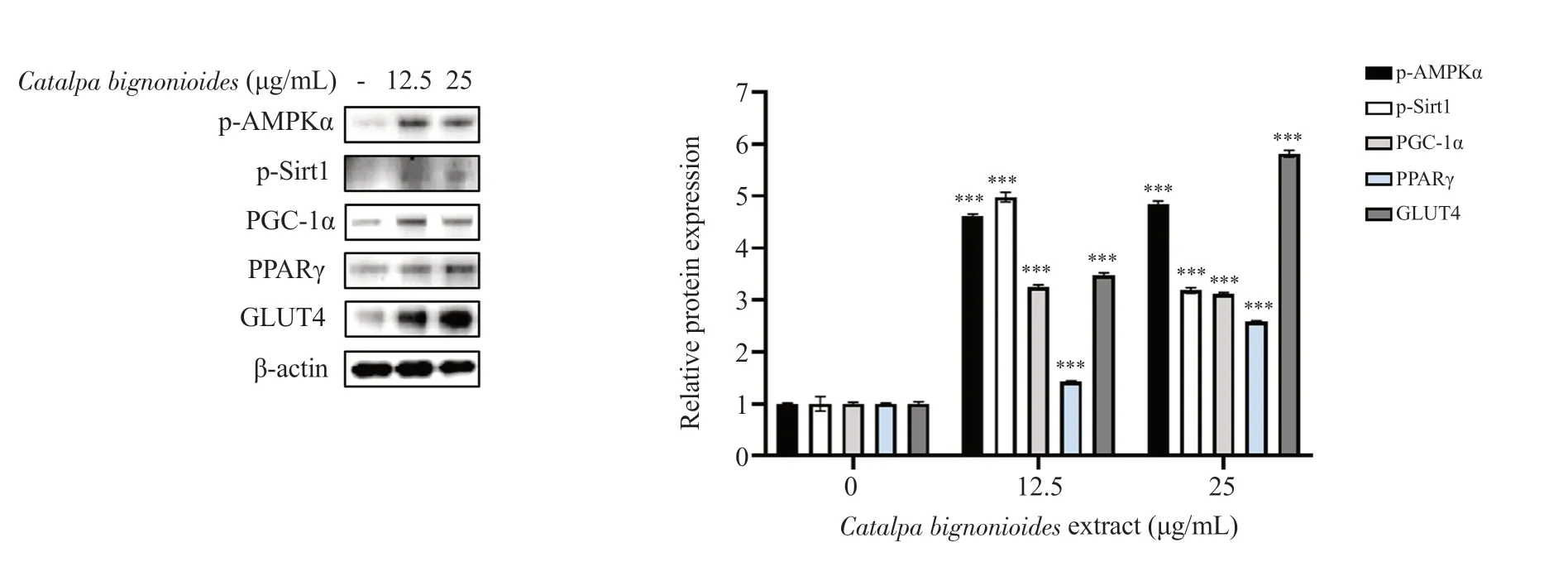
Figure 3.Mitochondrial metabolism is stimulated by Catalpa bignonioides extract in C2C12 cells.The levels of mitochondrial biosynthesis (p-AMPKα,p-Sirt1,and PGC-1α) and glucose metabolism (PPARγ and GLUT4) were determined using Western blot analysis.β-actin was used as the loading control.Data are represented as mean ± SEM of measurements in at least triplicate.***P < 0.001 compared with the control.
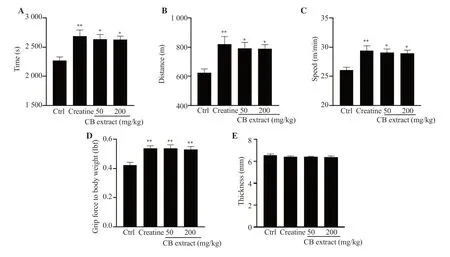
Figure 4.Improved motor performance of mice treated with Catalpa bignonioides extract.Time (A),distance (B),and maximum speed (C) before exhaustion on the treadmill in mice supplemented with distilled water (Ctrl),creatine (200 mg/kg),or Catalpa bignonioides extract (50 and 200 mg/kg).Grip strength (D)and leg muscle thickness (E) were measured in mice.Data are expressed as mean ± SEM (n=8 mice per Catalpa bignonioides extract 200 mg/kg group and n=9 mice per the other groups).* and ** indicate P < 0.05 and P < 0.01 compared with the control,respectively.CB: Catalpa bignonioides.

Figure 5.Biotoxicity assay in mice treated with Catalpa bignonioides extract.Changes in body weight over 10 weeks (A) and serum levels of ALT (B) and AST (C) were determined in mice supplemented with distilled water (Ctrl),creatine (200 mg/kg),or Catalpa bignonioides extract (50 and 200 mg/kg).Data are expressed as mean ± SEM (n=8 mice per Catalpa bignonioides extract 200 mg/kg group and n=9 mice per the other groups).ALT: alanine aminotransferase;AST: aspartate aminotransferase.
3.3.Energy metabolism is modulated in C.bignonioidestreated skeletal muscle cells
To explore the mitochondrial energy metabolism induced by theC.bignonioidesextract,Western blot analyses were performed to determine the factors related to mitochondrial biogenesis and glucose metabolism in C2C12 skeletal muscle cells.We found that treatment withC.bignonioidesextracts markedly increased the protein expression of PGC-1α,promoting mitochondrial biogenesis and the phosphorylation of AMPKα and Sirt1,which are regulators of PGC-1α,in C2C12 (P<0.001) (Figure 3).Furthermore,the expressions of PPARγ (which regulates glucose uptake in skeletal muscle) and GLUT4 (a downstream target of PPARγ and AMPK)were pronouncedly increased in C2C12 cells treated with both concentrations ofC.bignonioidesextract (P<0.001).
3.4.Exercise performance is enhanced in C.bignonioides extract-treated mice
To analyze thein vivoeffect ofC.bignonioidesextract on proliferation and energy metabolism in muscle cells,a muscular endurance test was conducted using the motorized treadmill following administration of theC.bignonioidesextract for 10 weeks.Extract-treated mice showed significantly increased running time,distance,and maximum speed to exhaustion compared to those recorded in the control group (P<0.05);moreover,they showed improved exercise capacity,similar to that of the creatinesupplemented group used as a positive control (Figure 4A-C).The whole-limb grip strength assay revealed enhanced muscular strength in mice treated withC.bignonioidesextract (Figure 4D).No change in thigh thickness was noted at the end of the experiment (Figure 4E).The exposure to the extract for 10 weeks neither altered the body weight of the mice (Figure 5A) nor increased the levels of ALT and AST in serum (Figure 5B and 5C),which suggested thatC.bignonioidesextract improved exercise performance without causing significant biotoxicity or liver damage to mice.
3.5.Analysis of vanillic acid and pinoresinol in C.bignonioides
The presence of vanillic acid and pinoresinol inC.bignonioideswas confirmed by comparing their retention time with that of standard compounds.The retention time of vanillic acid was found to be 7.154 min.C.bignonioidescontained 9.222 mg/g vanillic acid,but pinoresinol was not detected (Figure 6).

Figure 6.High-performance liquid chromatography chromatogram of vanillic acid and pinoresinol.Vanillic acid is marked with a blue box.
4.Discussion
During aging,various changes in biochemical signaling pathways and breakdown of muscular homeostasis result in a natural decline in skeletal muscle mass and strength[28].The amount of muscle and exercise capacity needs to be maintained using supplements with biosafety to overcome muscle loss.This study demonstrated that the extract collected fromC.bignonioides(an indigenous medicinal plant) induces muscle growth and improves muscle strength.The extract promoted proliferation and energy metabolism in C2C12 mouse myoblasts and muscular endurance and strip strength significantly increased when administered orally.These results suggest the efficacy ofC.bignonioidesextract as an adjuvant for enhancing muscle strength function.
Proliferation and differentiation of muscle cells are promoted through the activation of the IGF-1 signaling pathway[29,30].Regulation of skeletal muscle growth is associated with the Akt/mTOR signaling.Akt is activatedviaphosphorylation,plays an important role in muscle cell proliferation,and induces muscle hypertrophy when sufficient energy sources (such as growth factors and sugars) are available[5,31].Activated Akt triggers phosphorylation cascades in the mTOR and p70S6K pathways,and the expression levels of regulatory factors related to proliferation and protein synthesis are elevated.MyoD and myogenin are myogenic regulatory factors required for myogenesis in proliferating myoblasts[32].We previously demonstrated that specific compounds isolated fromC.bignonioidesfruits regulate the proliferation of C2C12 cellsviathe IGF-1 signaling[23].We demonstrated thatC.bignonioidesextract promoted the proliferation of differentiating C2C12 myoblastsviaactivation of the Akt/mTOR signaling and increased Myo D and myogenin expression.
Skeletal muscles consume energy generated in the mitochondria for their contraction;therefore,an increase in the number of mitochondria and activation of mitochondrial metabolism are associated with increased muscle strength[33].Adenosine triphosphate (ATP) is produced in the mitochondria,and mitochondrial biosynthesis is regulated by PGC-1α activation through energy sensors,AMPK,and Sirt1[34].Phosphorylation of AMPKα (the catalytic subunit of AMPK complex) occurs when the adenosine monophosphate (AMP)/ATP ratio increases after ATP consumption,and its function is activated.Sirt1 is an NAD+-dependent deacetylase,activated by phosphorylation when the NAD+/NADH ratio increases[34].AMPK and Sirt1 facilitate the activity of PGC-1α (a master regulator of mitochondrial biosynthesis and function) through phosphorylation and deacetylation,respectively[35].Therefore,activation of AMPK,Sirt1,and PGC-1α that stimulate mitochondrial biosynthesis is required to enhance metabolic efficacy to improve muscle performance.Activated AMPK is also recognized as a key regulator of energy metabolism in skeletal muscle,facilitating glucose uptake and increasing insulin sensitivity[36].It regulates PPARγ,improving glucose and fatty acid metabolism in skeletal muscle[37].GLUT4 is an insulin-dependent glucose transporter mainly distributed in skeletal muscle and adipose tissue that is expressed by AMPK and PPARγ to move glucose from the outside to the inside of the cell[38,39].In this study,C.bignonioidesextract increased the phosphorylation of AMPKα and Sirt1 in C2C12 cells and the expression of their target molecule,PGC-1α,which is expected to increase the number of mitochondria.In addition,it increased the protein levels of PPARγ and GLUT4,which are downstream targets of AMPK;this in turn promoted glucose uptake,which is essential for glycolysis required for muscle contraction and exercise.Furthermore,C.bignonioidesextract-treated mice significantly increased running time,distance,speed,and grip force to body weight compared with control mice.These data suggest that theC.bignonioidesextract may modulate metabolism in muscle cells,induce their proliferation,increase mitochondrial numbersin vitro,and improve exercise performancein vivo.
C.bignonioidesextract contains several compounds such as isolariciresinol,pinoresinol,catalposide,vanillic acid,and minecoside.Kimet al.demonstrated that many compounds of theC.bignonioidesextract promote the proliferation of C2C12 cells,with vanillic acid and pinoresinol showing the best efficacy[23].Moreover,vanillic acid improves the proliferation of myoblasts through the IGF-1R/Akt/mTOR signaling pathway[23].Vanillic acid was detected in theC.bignonioidesextract,which improved the motor performance in mice.Therefore,it is indicated that vanillic acid is the main active compound ofC.bignonioidesextract that enhances exercise performancein vitro.
The main limitation of this study is that we did not demonstrate additional mechanisms in mice.Moreover,the effect of vanillic acidin vivowas not proved.Therefore,further studies are needed to demonstrate the mechanistic studies ofC.bignonioidesextract and the effect of vanillic acidin vivo.
In summary,this study demonstrated the potential effect ofC.bignonioideson muscle growth and strength improvement.C.bignonioidesextract increased muscle cell proliferationviathe Akt/mTOR signaling and improved energy metabolism,increasing the number of mitochondria,and promoting glucose oxidation.Furthermore,a significantly enhanced exercise capacity was detected in mice.Hence,all these results indicate thatC.bignonioidesextract could help prevent muscle loss and maintain muscular strength.
Conflict of interest statement
The authors declare no conflict of interest.
Funding
This work was supported by Korea Environment Industry &Technology Institute through Project to make multi-ministerial national biological research resources more advanced Project,funded by Korea Ministry of Environment (grant number RS-2023-00230403).
Data availability statement
The data supporting the findings of this study are available from the corresponding authors upon request.
Authors’contributions
SHC and KNK supervised and designed the study.HJ,DJL,SPK,SRK,JWP,BY,JIP,and SHC performed experimental analysis.HJ,DCL,KMC,and WWL performed the analytic calculation.SP and SHK provided the resources.HJ,DJL,SHC,KNK contributed to the final version of the manuscript.KNK supervised the project.
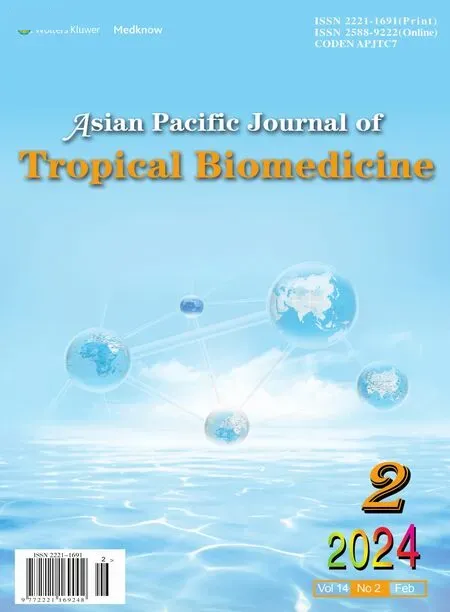 Asian Pacific Journal of Tropical Biomedicine2024年2期
Asian Pacific Journal of Tropical Biomedicine2024年2期
- Asian Pacific Journal of Tropical Biomedicine的其它文章
- Icariin plus curcumol enhances autophagy through the mTOR pathway and promotes cathepsin B-mediated pyroptosis of prostate cancer cells
- Hydrangea serrata extract exerts tumor inhibitory activity against hepatocellular carcinoma HepG2 cells via inducing p27/CDK2-mediated cell cycle arrest and apoptosis
- Benzydamine hydrochloride ameliorates ethanol-induced inflammation in RAW 264.7 macrophages by stabilizing redox homeostasis
- NUDT5 promotes the growth,metastasis,and Warburg effect of IDH wild-type glioblastoma multiforme cells by upregulating TRIM47
